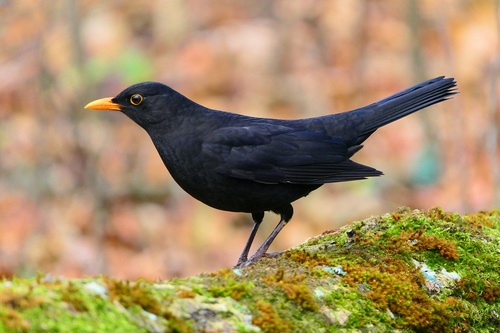
Eurasian Blackbird
The Eurasian Blackbird (Turdus merula) is a familiar sight and sound in gardens, woodlands, and parks across Europe and parts of Asia and North Africa. It has also been introduced to Australia and New Zealand. Known for its melodious song, particularly the male's rich, fluting calls delivered from rooftops or high perches, the blackbird plays an important ecological role as a seed disperser and controller of invertebrate populations. While not generally considered of significant cultural importance, its song has been featured in poetry and music, reflecting its close association with human-inhabited landscapes.
23.5-29 cm
Length
34-38.5 cm
Wingspan
Least Concern
Conservation Status
Distribution
Native to Europe, North Africa, and parts of Asia (including the Middle East, India, and China). Introduced populations exist in Australia and New Zealand. Generally non-migratory in milder western and southern Europe, but northern and eastern populations migrate south for the winter. Altitudinal range varies from sea level to higher elevations in mountainous regions, depending on food availability.
Lifespan
Typical lifespan in the wild is around 3-4 years, although some individuals have been recorded living over 20 years.
Eurasian Blackbird's Habitat
Habitat Types
Woodlands, Gardens, Parks, Farmland, Hedgerows, Coastal dunes
Climate Zones
Temperate, Mediterranean, Subtropical
Adaptations
Highly adaptable to a wide range of habitats, from dense forests to urban environments. Their ability to utilize various food sources and nesting sites contributes to their success.
Variations
Several subspecies are recognized, differing slightly in size, plumage coloration, and vocalizations. For example, some island populations may exhibit darker plumage or larger body sizes.
Appearance
Breeding Plumage
Adult males have glossy black plumage year-round. Females and juveniles have dark brown plumage, often with a mottled breast.
Seasonal Feather Changes
Minimal seasonal variation, although plumage may appear slightly duller after molting.
Sex Based Plumage Differences
Strong sexual dimorphism. Males are black with a bright yellow-orange eye-ring and bill. Females are brown with a less distinct eye-ring and a duller yellowish-brown bill.
Notable Features
Bright yellow-orange eye-ring (adult male), Yellow-orange bill (adult male), Strong legs and feet adapted for ground foraging
Diet and Feeding
Primary Foods
Invertebrates (earthworms, insects, snails), Berries, Fruits, Seeds
Foraging Behavior
Primarily forages on the ground, hopping and running, often turning over leaves and probing the soil with its bill. Also takes fruit from trees and bushes.
Specializations
No highly specialized feeding adaptations, but their strong bill and legs are well-suited for their diverse diet.
Seasonal Diet Variations
Diet shifts seasonally depending on food availability. Invertebrates are more important during the breeding season, while fruits and berries become a major food source in autumn and winter.
Behavior
Social Structure
Generally territorial during the breeding season, but may form small flocks in winter, especially at feeding sites.
Communication
Melodious song (primarily by males), Alarm calls (a sharp 'chink' or 'chook'), Submissive postures (crouching, wing-flicking)
Migration
Northern and eastern populations are migratory, moving south for the winter. Western and southern European populations are largely resident.
Territorial or Group Behaviors
Males defend territories during the breeding season through song and aggressive displays. In winter, they may tolerate closer proximity to other blackbirds.
Conservation
Threats
Habitat loss (due to urbanization and agricultural intensification), Predation (by cats, raptors, and other predators), Pesticide use (reducing invertebrate prey)
Protection Programs
General wildlife protection laws, Habitat conservation and restoration initiatives
Local National Laws
Protected under various national and international wildlife legislation (e.g., the EU Birds Directive).
Population Trend
Stable
Population Estimates
Estimated global population of 160-400 million individuals.
Interesting Facts
The Eurasian Blackbird's song is highly variable.
Individual males have their own unique repertoire of phrases, and regional dialects can exist.
They are known to 'worm-charm'.
Blackbirds sometimes tap the ground with their feet, possibly mimicking raindrops to encourage earthworms to come to the surface.
Introduced populations in Australia and New Zealand have diverged slightly.
These populations show some differences in morphology and behavior compared to their European counterparts.
Faqs about Eurasian Blackbird
What do I do if I find a baby blackbird?
If the bird is feathered and hopping, it is likely a fledgling and its parents are probably nearby. It's best to leave it alone unless it is in immediate danger. If it is unfeathered or injured, contact a local wildlife rehabilitator. *Consult a professional for expert advice.*
Why are blackbirds so common in gardens?
Blackbirds have adapted well to human-modified environments, finding food and nesting sites in gardens and parks.
How can I attract blackbirds to my garden?
Provide a source of fresh water, plant berry-producing shrubs, and avoid using pesticides.
Are Eurasian Blackbirds aggressive?
Males can be territorial during breeding, chasing away other males. Otherwise, they are not typically agressive towards humans.
Copyright @ Nature Style Limited. All Rights Reserved.
 English
English